Comparative Analysis of Taxation Systems: Australia and India
VerifiedAdded on 2023/01/03
|8
|1738
|77
Report
AI Summary
This report offers a comparative analysis of the tax systems of Australia and India, focusing on key aspects such as fairness, adequacy, simplicity, transparency, and administrative ease. It begins by outlining the fundamental differences in the tax policies of the two countries, including the roles of federal and state governments in tax administration. The report delves into the concept of fairness, examining how each country addresses tax-related residency rules and the imposition of taxes on business risks and individual income. It assesses the adequacy of each system by considering what is deemed as taxable income, including salaries, wages, and capital gains. The report also evaluates the simplicity and transparency of the tax systems, highlighting the challenges and advancements in both countries. Finally, it explores the administrative ease of each system, considering how capital gains and other assets are handled. The conclusion summarizes the key findings and provides insights into the strengths and weaknesses of each system, offering a comprehensive overview of the comparative analysis.
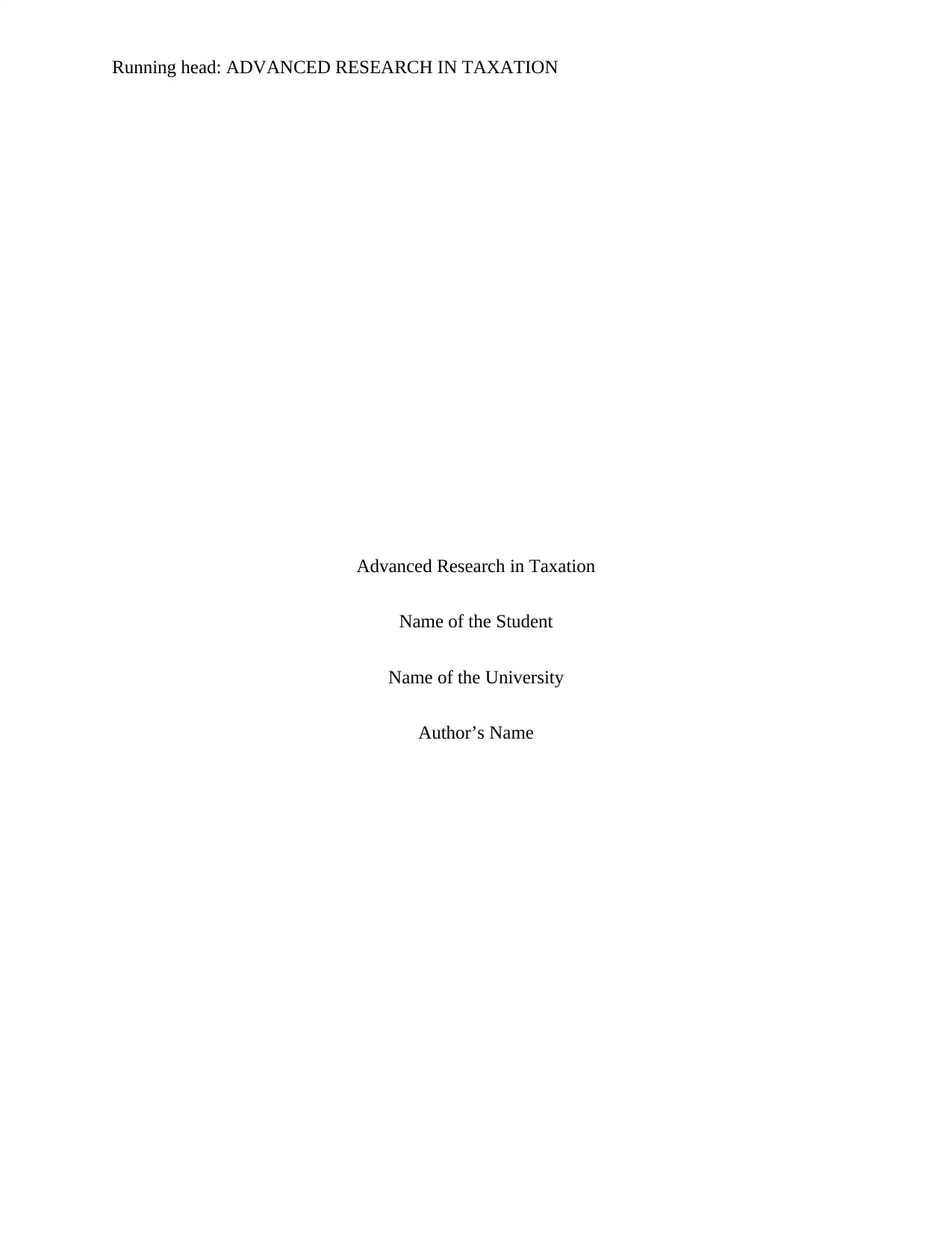
Running head: ADVANCED RESEARCH IN TAXATION
Advanced Research in Taxation
Name of the Student
Name of the University
Author’s Name
Advanced Research in Taxation
Name of the Student
Name of the University
Author’s Name
Paraphrase This Document
Need a fresh take? Get an instant paraphrase of this document with our AI Paraphraser
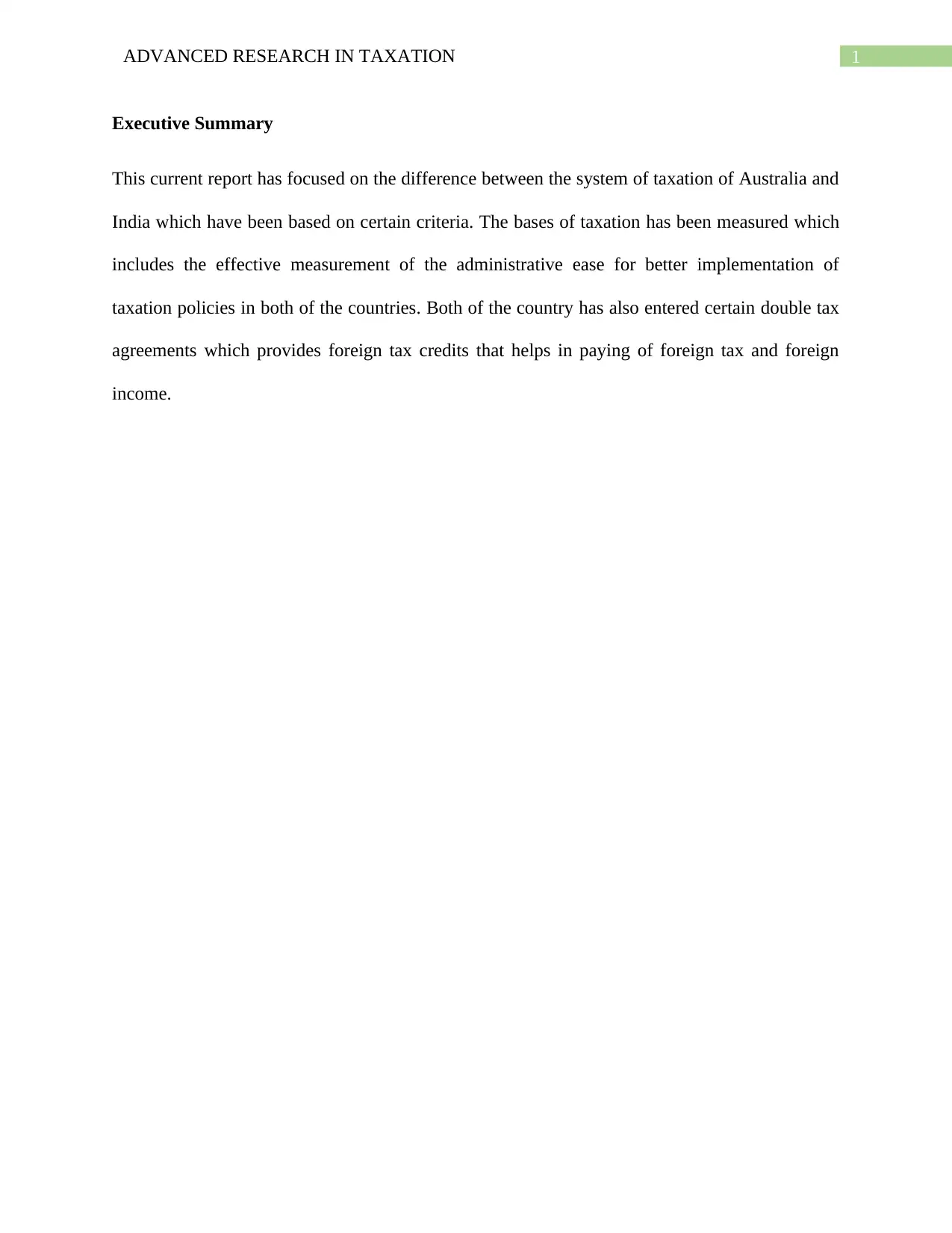
1ADVANCED RESEARCH IN TAXATION
Executive Summary
This current report has focused on the difference between the system of taxation of Australia and
India which have been based on certain criteria. The bases of taxation has been measured which
includes the effective measurement of the administrative ease for better implementation of
taxation policies in both of the countries. Both of the country has also entered certain double tax
agreements which provides foreign tax credits that helps in paying of foreign tax and foreign
income.
Executive Summary
This current report has focused on the difference between the system of taxation of Australia and
India which have been based on certain criteria. The bases of taxation has been measured which
includes the effective measurement of the administrative ease for better implementation of
taxation policies in both of the countries. Both of the country has also entered certain double tax
agreements which provides foreign tax credits that helps in paying of foreign tax and foreign
income.
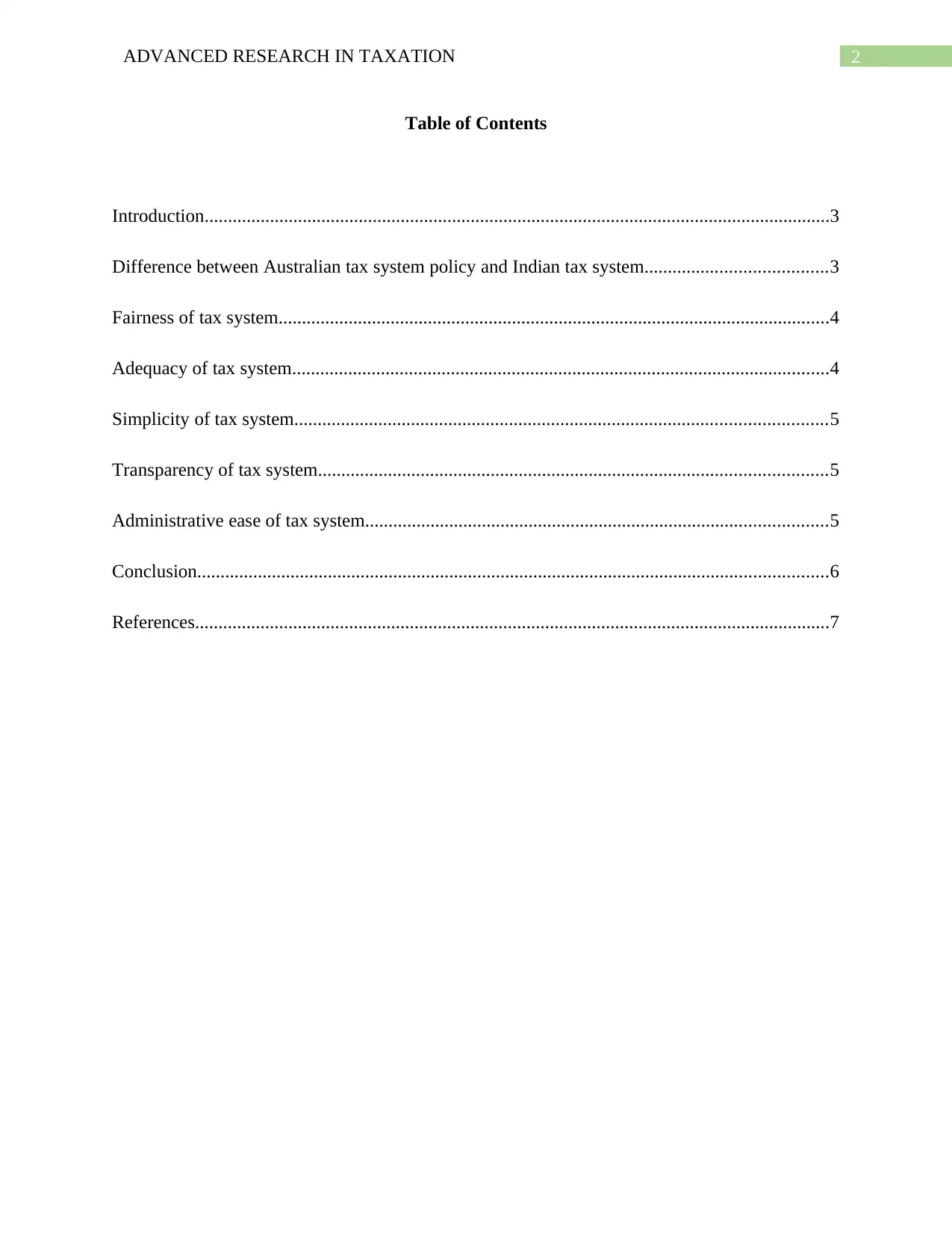
2ADVANCED RESEARCH IN TAXATION
Table of Contents
Introduction......................................................................................................................................3
Difference between Australian tax system policy and Indian tax system.......................................3
Fairness of tax system......................................................................................................................4
Adequacy of tax system...................................................................................................................4
Simplicity of tax system..................................................................................................................5
Transparency of tax system.............................................................................................................5
Administrative ease of tax system...................................................................................................5
Conclusion.......................................................................................................................................6
References........................................................................................................................................7
Table of Contents
Introduction......................................................................................................................................3
Difference between Australian tax system policy and Indian tax system.......................................3
Fairness of tax system......................................................................................................................4
Adequacy of tax system...................................................................................................................4
Simplicity of tax system..................................................................................................................5
Transparency of tax system.............................................................................................................5
Administrative ease of tax system...................................................................................................5
Conclusion.......................................................................................................................................6
References........................................................................................................................................7
⊘ This is a preview!⊘
Do you want full access?
Subscribe today to unlock all pages.

Trusted by 1+ million students worldwide
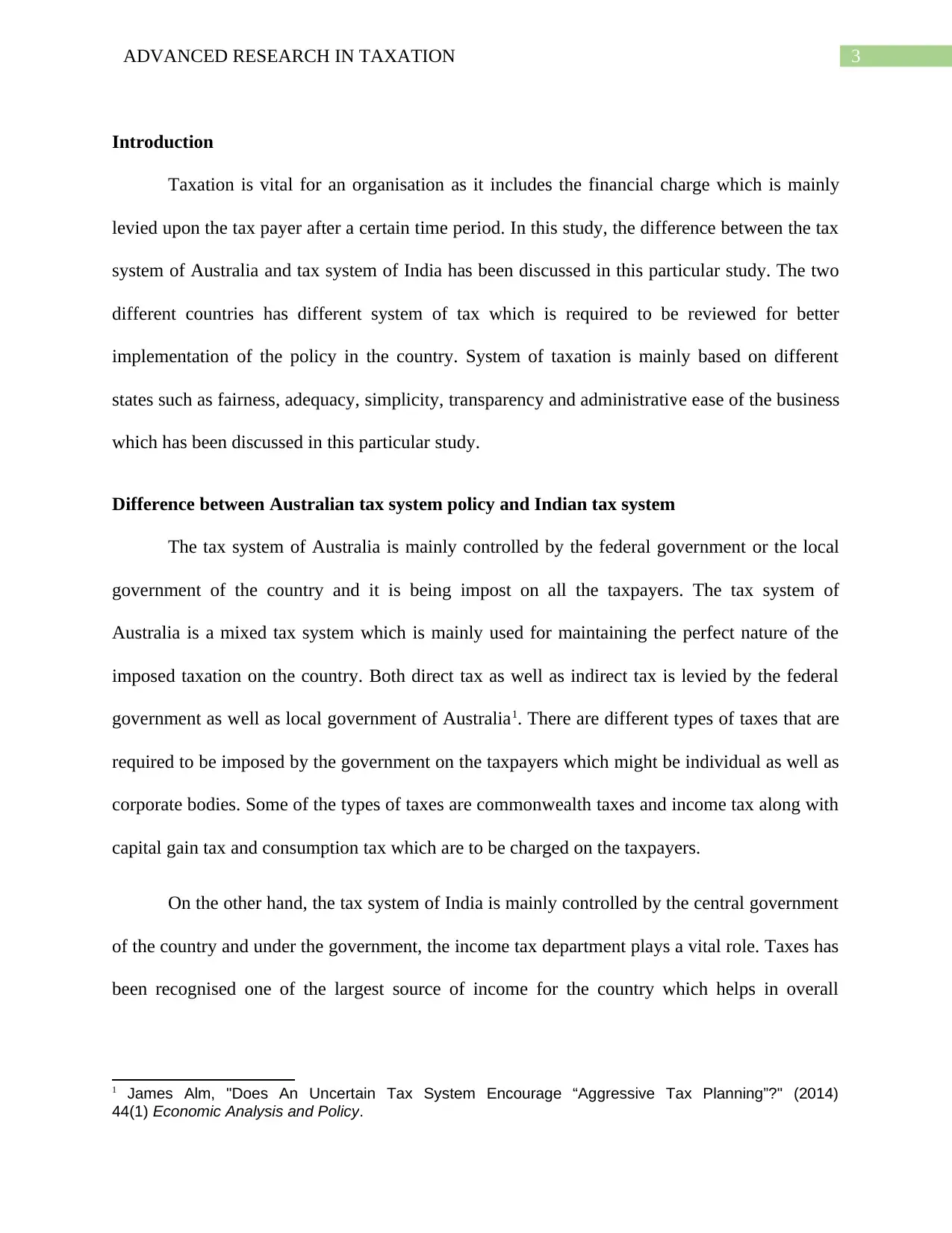
3ADVANCED RESEARCH IN TAXATION
Introduction
Taxation is vital for an organisation as it includes the financial charge which is mainly
levied upon the tax payer after a certain time period. In this study, the difference between the tax
system of Australia and tax system of India has been discussed in this particular study. The two
different countries has different system of tax which is required to be reviewed for better
implementation of the policy in the country. System of taxation is mainly based on different
states such as fairness, adequacy, simplicity, transparency and administrative ease of the business
which has been discussed in this particular study.
Difference between Australian tax system policy and Indian tax system
The tax system of Australia is mainly controlled by the federal government or the local
government of the country and it is being impost on all the taxpayers. The tax system of
Australia is a mixed tax system which is mainly used for maintaining the perfect nature of the
imposed taxation on the country. Both direct tax as well as indirect tax is levied by the federal
government as well as local government of Australia1. There are different types of taxes that are
required to be imposed by the government on the taxpayers which might be individual as well as
corporate bodies. Some of the types of taxes are commonwealth taxes and income tax along with
capital gain tax and consumption tax which are to be charged on the taxpayers.
On the other hand, the tax system of India is mainly controlled by the central government
of the country and under the government, the income tax department plays a vital role. Taxes has
been recognised one of the largest source of income for the country which helps in overall
1 James Alm, "Does An Uncertain Tax System Encourage “Aggressive Tax Planning”?" (2014)
44(1) Economic Analysis and Policy.
Introduction
Taxation is vital for an organisation as it includes the financial charge which is mainly
levied upon the tax payer after a certain time period. In this study, the difference between the tax
system of Australia and tax system of India has been discussed in this particular study. The two
different countries has different system of tax which is required to be reviewed for better
implementation of the policy in the country. System of taxation is mainly based on different
states such as fairness, adequacy, simplicity, transparency and administrative ease of the business
which has been discussed in this particular study.
Difference between Australian tax system policy and Indian tax system
The tax system of Australia is mainly controlled by the federal government or the local
government of the country and it is being impost on all the taxpayers. The tax system of
Australia is a mixed tax system which is mainly used for maintaining the perfect nature of the
imposed taxation on the country. Both direct tax as well as indirect tax is levied by the federal
government as well as local government of Australia1. There are different types of taxes that are
required to be imposed by the government on the taxpayers which might be individual as well as
corporate bodies. Some of the types of taxes are commonwealth taxes and income tax along with
capital gain tax and consumption tax which are to be charged on the taxpayers.
On the other hand, the tax system of India is mainly controlled by the central government
of the country and under the government, the income tax department plays a vital role. Taxes has
been recognised one of the largest source of income for the country which helps in overall
1 James Alm, "Does An Uncertain Tax System Encourage “Aggressive Tax Planning”?" (2014)
44(1) Economic Analysis and Policy.
Paraphrase This Document
Need a fresh take? Get an instant paraphrase of this document with our AI Paraphraser
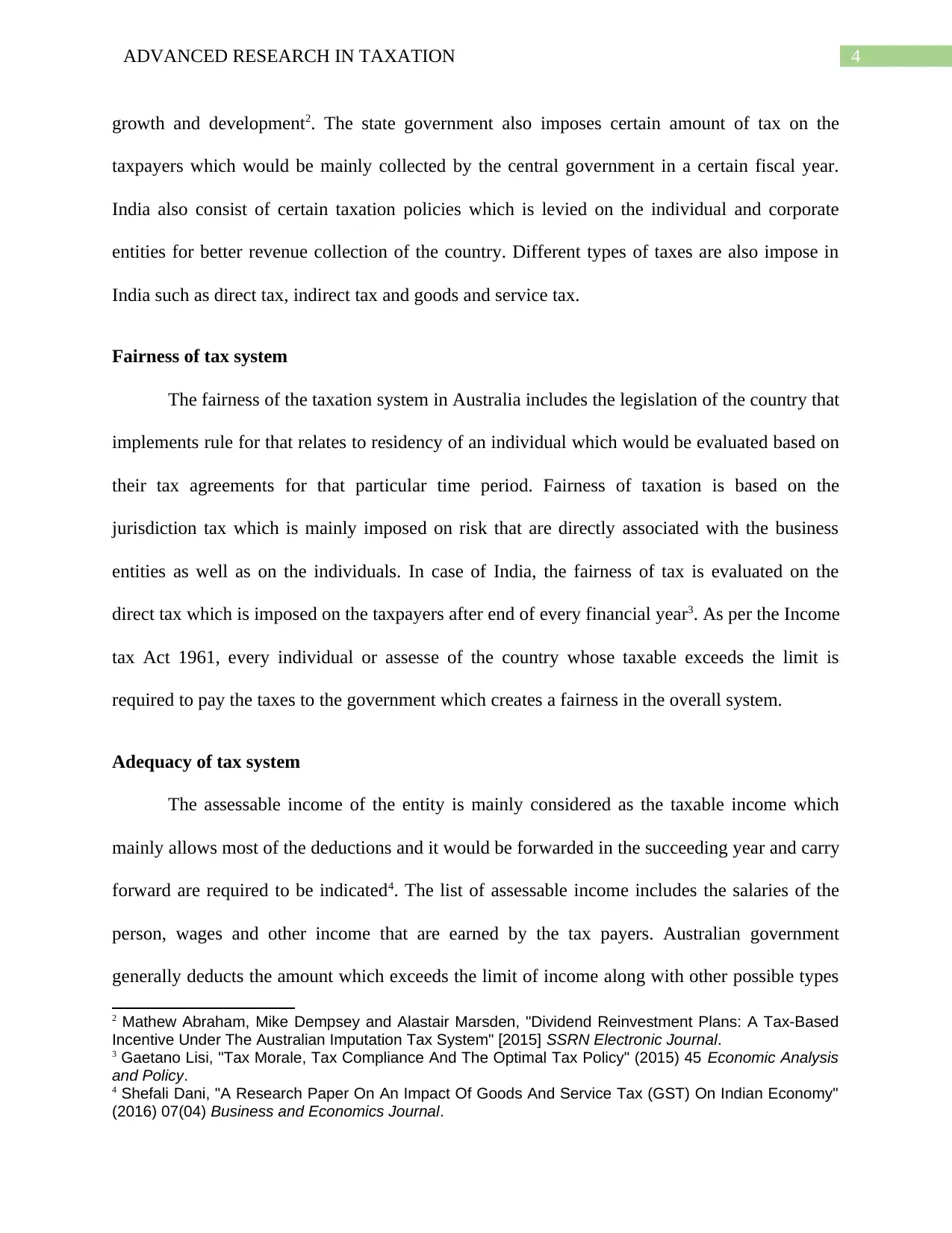
4ADVANCED RESEARCH IN TAXATION
growth and development2. The state government also imposes certain amount of tax on the
taxpayers which would be mainly collected by the central government in a certain fiscal year.
India also consist of certain taxation policies which is levied on the individual and corporate
entities for better revenue collection of the country. Different types of taxes are also impose in
India such as direct tax, indirect tax and goods and service tax.
Fairness of tax system
The fairness of the taxation system in Australia includes the legislation of the country that
implements rule for that relates to residency of an individual which would be evaluated based on
their tax agreements for that particular time period. Fairness of taxation is based on the
jurisdiction tax which is mainly imposed on risk that are directly associated with the business
entities as well as on the individuals. In case of India, the fairness of tax is evaluated on the
direct tax which is imposed on the taxpayers after end of every financial year3. As per the Income
tax Act 1961, every individual or assesse of the country whose taxable exceeds the limit is
required to pay the taxes to the government which creates a fairness in the overall system.
Adequacy of tax system
The assessable income of the entity is mainly considered as the taxable income which
mainly allows most of the deductions and it would be forwarded in the succeeding year and carry
forward are required to be indicated4. The list of assessable income includes the salaries of the
person, wages and other income that are earned by the tax payers. Australian government
generally deducts the amount which exceeds the limit of income along with other possible types
2 Mathew Abraham, Mike Dempsey and Alastair Marsden, "Dividend Reinvestment Plans: A Tax-Based
Incentive Under The Australian Imputation Tax System" [2015] SSRN Electronic Journal.
3 Gaetano Lisi, "Tax Morale, Tax Compliance And The Optimal Tax Policy" (2015) 45 Economic Analysis
and Policy.
4 Shefali Dani, "A Research Paper On An Impact Of Goods And Service Tax (GST) On Indian Economy"
(2016) 07(04) Business and Economics Journal.
growth and development2. The state government also imposes certain amount of tax on the
taxpayers which would be mainly collected by the central government in a certain fiscal year.
India also consist of certain taxation policies which is levied on the individual and corporate
entities for better revenue collection of the country. Different types of taxes are also impose in
India such as direct tax, indirect tax and goods and service tax.
Fairness of tax system
The fairness of the taxation system in Australia includes the legislation of the country that
implements rule for that relates to residency of an individual which would be evaluated based on
their tax agreements for that particular time period. Fairness of taxation is based on the
jurisdiction tax which is mainly imposed on risk that are directly associated with the business
entities as well as on the individuals. In case of India, the fairness of tax is evaluated on the
direct tax which is imposed on the taxpayers after end of every financial year3. As per the Income
tax Act 1961, every individual or assesse of the country whose taxable exceeds the limit is
required to pay the taxes to the government which creates a fairness in the overall system.
Adequacy of tax system
The assessable income of the entity is mainly considered as the taxable income which
mainly allows most of the deductions and it would be forwarded in the succeeding year and carry
forward are required to be indicated4. The list of assessable income includes the salaries of the
person, wages and other income that are earned by the tax payers. Australian government
generally deducts the amount which exceeds the limit of income along with other possible types
2 Mathew Abraham, Mike Dempsey and Alastair Marsden, "Dividend Reinvestment Plans: A Tax-Based
Incentive Under The Australian Imputation Tax System" [2015] SSRN Electronic Journal.
3 Gaetano Lisi, "Tax Morale, Tax Compliance And The Optimal Tax Policy" (2015) 45 Economic Analysis
and Policy.
4 Shefali Dani, "A Research Paper On An Impact Of Goods And Service Tax (GST) On Indian Economy"
(2016) 07(04) Business and Economics Journal.
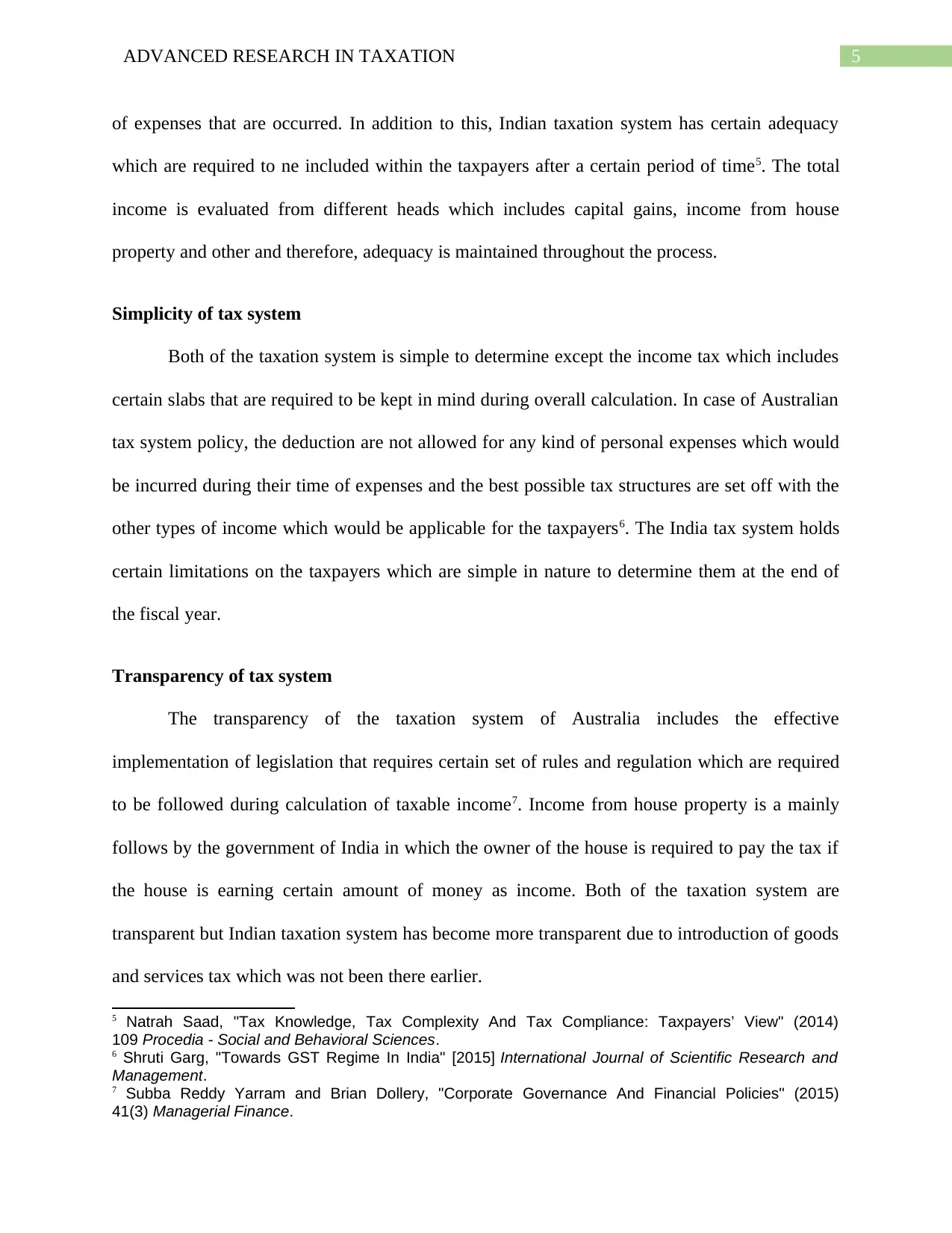
5ADVANCED RESEARCH IN TAXATION
of expenses that are occurred. In addition to this, Indian taxation system has certain adequacy
which are required to ne included within the taxpayers after a certain period of time5. The total
income is evaluated from different heads which includes capital gains, income from house
property and other and therefore, adequacy is maintained throughout the process.
Simplicity of tax system
Both of the taxation system is simple to determine except the income tax which includes
certain slabs that are required to be kept in mind during overall calculation. In case of Australian
tax system policy, the deduction are not allowed for any kind of personal expenses which would
be incurred during their time of expenses and the best possible tax structures are set off with the
other types of income which would be applicable for the taxpayers6. The India tax system holds
certain limitations on the taxpayers which are simple in nature to determine them at the end of
the fiscal year.
Transparency of tax system
The transparency of the taxation system of Australia includes the effective
implementation of legislation that requires certain set of rules and regulation which are required
to be followed during calculation of taxable income7. Income from house property is a mainly
follows by the government of India in which the owner of the house is required to pay the tax if
the house is earning certain amount of money as income. Both of the taxation system are
transparent but Indian taxation system has become more transparent due to introduction of goods
and services tax which was not been there earlier.
5 Natrah Saad, "Tax Knowledge, Tax Complexity And Tax Compliance: Taxpayers’ View" (2014)
109 Procedia - Social and Behavioral Sciences.
6 Shruti Garg, "Towards GST Regime In India" [2015] International Journal of Scientific Research and
Management.
7 Subba Reddy Yarram and Brian Dollery, "Corporate Governance And Financial Policies" (2015)
41(3) Managerial Finance.
of expenses that are occurred. In addition to this, Indian taxation system has certain adequacy
which are required to ne included within the taxpayers after a certain period of time5. The total
income is evaluated from different heads which includes capital gains, income from house
property and other and therefore, adequacy is maintained throughout the process.
Simplicity of tax system
Both of the taxation system is simple to determine except the income tax which includes
certain slabs that are required to be kept in mind during overall calculation. In case of Australian
tax system policy, the deduction are not allowed for any kind of personal expenses which would
be incurred during their time of expenses and the best possible tax structures are set off with the
other types of income which would be applicable for the taxpayers6. The India tax system holds
certain limitations on the taxpayers which are simple in nature to determine them at the end of
the fiscal year.
Transparency of tax system
The transparency of the taxation system of Australia includes the effective
implementation of legislation that requires certain set of rules and regulation which are required
to be followed during calculation of taxable income7. Income from house property is a mainly
follows by the government of India in which the owner of the house is required to pay the tax if
the house is earning certain amount of money as income. Both of the taxation system are
transparent but Indian taxation system has become more transparent due to introduction of goods
and services tax which was not been there earlier.
5 Natrah Saad, "Tax Knowledge, Tax Complexity And Tax Compliance: Taxpayers’ View" (2014)
109 Procedia - Social and Behavioral Sciences.
6 Shruti Garg, "Towards GST Regime In India" [2015] International Journal of Scientific Research and
Management.
7 Subba Reddy Yarram and Brian Dollery, "Corporate Governance And Financial Policies" (2015)
41(3) Managerial Finance.
⊘ This is a preview!⊘
Do you want full access?
Subscribe today to unlock all pages.

Trusted by 1+ million students worldwide
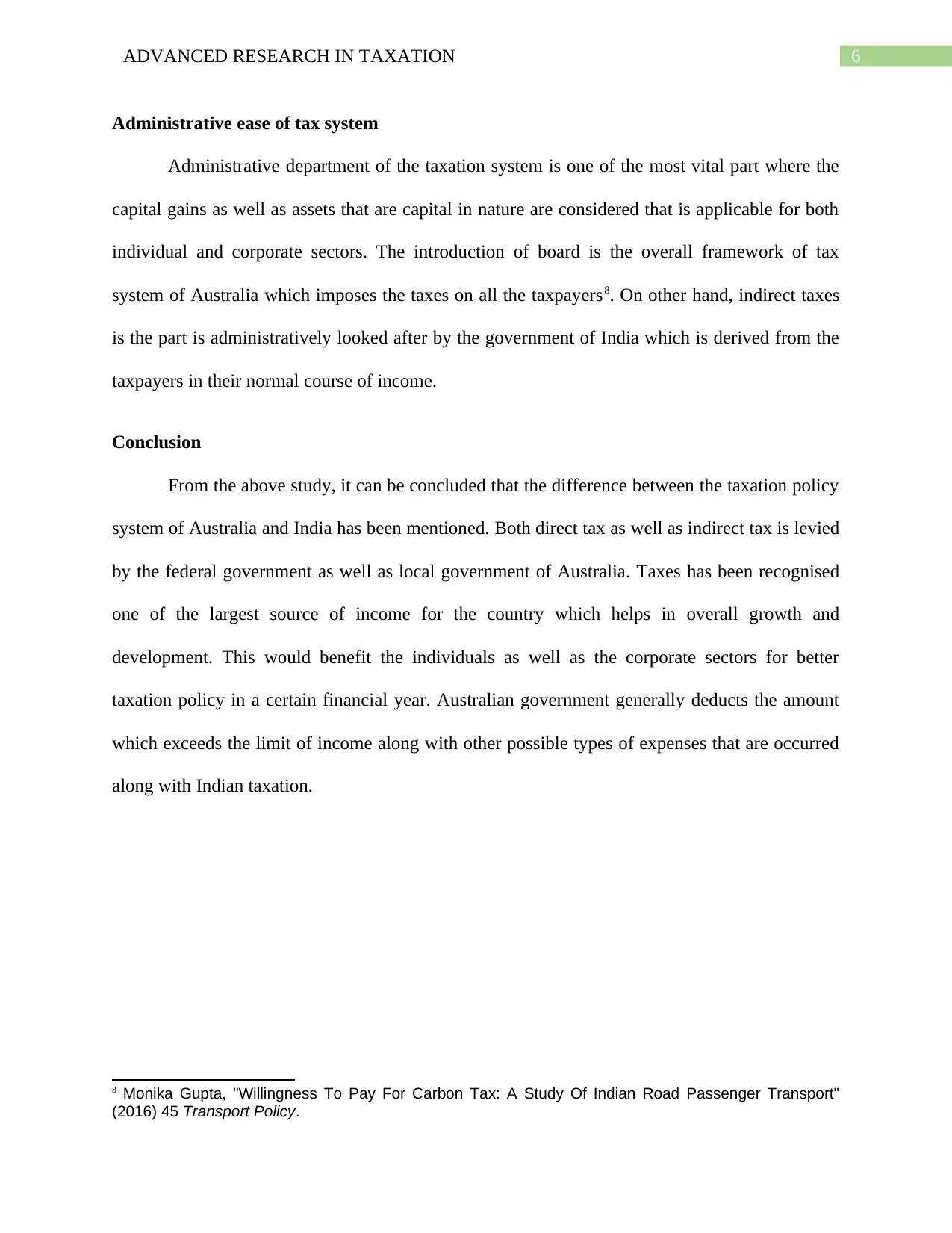
6ADVANCED RESEARCH IN TAXATION
Administrative ease of tax system
Administrative department of the taxation system is one of the most vital part where the
capital gains as well as assets that are capital in nature are considered that is applicable for both
individual and corporate sectors. The introduction of board is the overall framework of tax
system of Australia which imposes the taxes on all the taxpayers8. On other hand, indirect taxes
is the part is administratively looked after by the government of India which is derived from the
taxpayers in their normal course of income.
Conclusion
From the above study, it can be concluded that the difference between the taxation policy
system of Australia and India has been mentioned. Both direct tax as well as indirect tax is levied
by the federal government as well as local government of Australia. Taxes has been recognised
one of the largest source of income for the country which helps in overall growth and
development. This would benefit the individuals as well as the corporate sectors for better
taxation policy in a certain financial year. Australian government generally deducts the amount
which exceeds the limit of income along with other possible types of expenses that are occurred
along with Indian taxation.
8 Monika Gupta, "Willingness To Pay For Carbon Tax: A Study Of Indian Road Passenger Transport"
(2016) 45 Transport Policy.
Administrative ease of tax system
Administrative department of the taxation system is one of the most vital part where the
capital gains as well as assets that are capital in nature are considered that is applicable for both
individual and corporate sectors. The introduction of board is the overall framework of tax
system of Australia which imposes the taxes on all the taxpayers8. On other hand, indirect taxes
is the part is administratively looked after by the government of India which is derived from the
taxpayers in their normal course of income.
Conclusion
From the above study, it can be concluded that the difference between the taxation policy
system of Australia and India has been mentioned. Both direct tax as well as indirect tax is levied
by the federal government as well as local government of Australia. Taxes has been recognised
one of the largest source of income for the country which helps in overall growth and
development. This would benefit the individuals as well as the corporate sectors for better
taxation policy in a certain financial year. Australian government generally deducts the amount
which exceeds the limit of income along with other possible types of expenses that are occurred
along with Indian taxation.
8 Monika Gupta, "Willingness To Pay For Carbon Tax: A Study Of Indian Road Passenger Transport"
(2016) 45 Transport Policy.
Paraphrase This Document
Need a fresh take? Get an instant paraphrase of this document with our AI Paraphraser
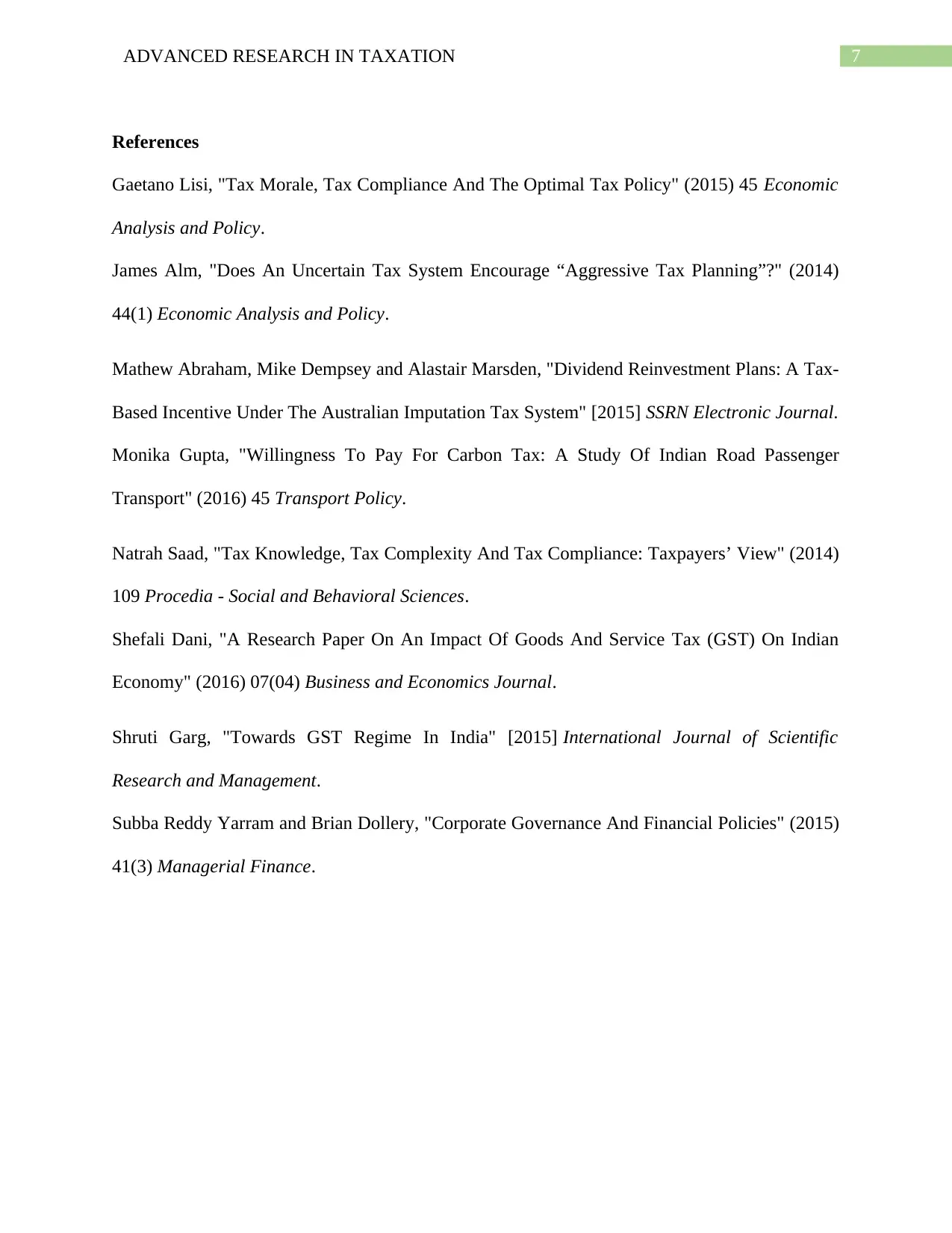
7ADVANCED RESEARCH IN TAXATION
References
Gaetano Lisi, "Tax Morale, Tax Compliance And The Optimal Tax Policy" (2015) 45 Economic
Analysis and Policy.
James Alm, "Does An Uncertain Tax System Encourage “Aggressive Tax Planning”?" (2014)
44(1) Economic Analysis and Policy.
Mathew Abraham, Mike Dempsey and Alastair Marsden, "Dividend Reinvestment Plans: A Tax-
Based Incentive Under The Australian Imputation Tax System" [2015] SSRN Electronic Journal.
Monika Gupta, "Willingness To Pay For Carbon Tax: A Study Of Indian Road Passenger
Transport" (2016) 45 Transport Policy.
Natrah Saad, "Tax Knowledge, Tax Complexity And Tax Compliance: Taxpayers’ View" (2014)
109 Procedia - Social and Behavioral Sciences.
Shefali Dani, "A Research Paper On An Impact Of Goods And Service Tax (GST) On Indian
Economy" (2016) 07(04) Business and Economics Journal.
Shruti Garg, "Towards GST Regime In India" [2015] International Journal of Scientific
Research and Management.
Subba Reddy Yarram and Brian Dollery, "Corporate Governance And Financial Policies" (2015)
41(3) Managerial Finance.
References
Gaetano Lisi, "Tax Morale, Tax Compliance And The Optimal Tax Policy" (2015) 45 Economic
Analysis and Policy.
James Alm, "Does An Uncertain Tax System Encourage “Aggressive Tax Planning”?" (2014)
44(1) Economic Analysis and Policy.
Mathew Abraham, Mike Dempsey and Alastair Marsden, "Dividend Reinvestment Plans: A Tax-
Based Incentive Under The Australian Imputation Tax System" [2015] SSRN Electronic Journal.
Monika Gupta, "Willingness To Pay For Carbon Tax: A Study Of Indian Road Passenger
Transport" (2016) 45 Transport Policy.
Natrah Saad, "Tax Knowledge, Tax Complexity And Tax Compliance: Taxpayers’ View" (2014)
109 Procedia - Social and Behavioral Sciences.
Shefali Dani, "A Research Paper On An Impact Of Goods And Service Tax (GST) On Indian
Economy" (2016) 07(04) Business and Economics Journal.
Shruti Garg, "Towards GST Regime In India" [2015] International Journal of Scientific
Research and Management.
Subba Reddy Yarram and Brian Dollery, "Corporate Governance And Financial Policies" (2015)
41(3) Managerial Finance.
1 out of 8
Related Documents
Your All-in-One AI-Powered Toolkit for Academic Success.
+13062052269
info@desklib.com
Available 24*7 on WhatsApp / Email
![[object Object]](/_next/static/media/star-bottom.7253800d.svg)
Unlock your academic potential
Copyright © 2020–2025 A2Z Services. All Rights Reserved. Developed and managed by ZUCOL.





